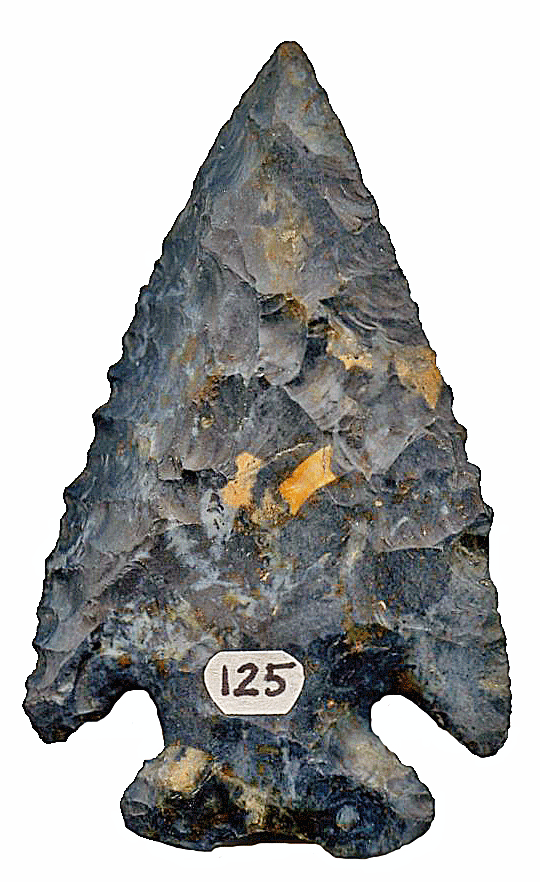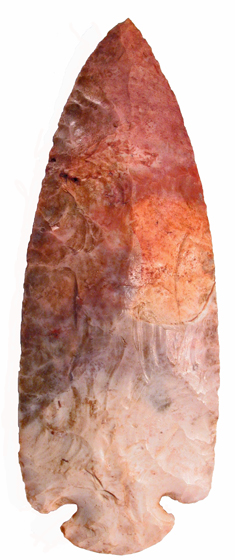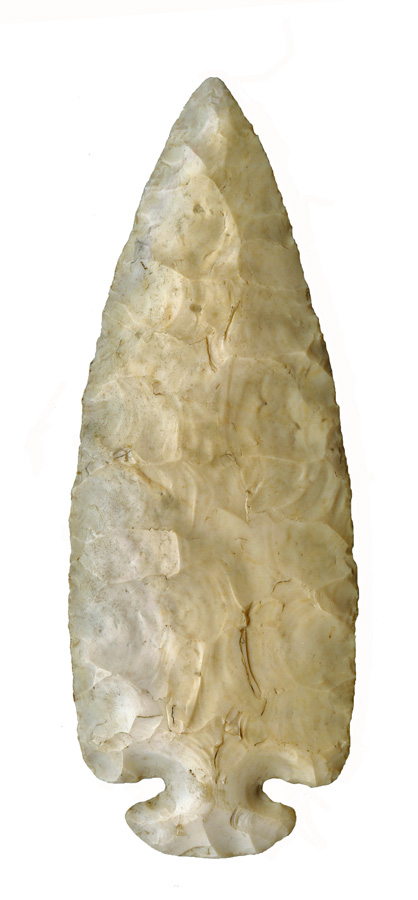





Point Type: ST.
CHARLES a.k.a.
Dovetail or Plevna or Circle-Top
Also See: Archaic Bevel, Bolen, Ecusta, Gibson, Hardin, Kirk Corner Notched , Lost Lake, Thebes
Location: Midwestern to Eastern United States
Associated Dates:
9000 - 5000 B.P. - Early Archaic - Middle Archaic
Morphology: Corner
Notched
General Description: The St. Charles (also known as the Dovetail or Plevna) is a medium to large point and has narrow corner or side notches which define the base or stem. The base is fan shaped and resembles the spread out tail of a dove, hence they have been known as Dovetails. The blade is triangular and has a broad wide face with excurvate edges and a lenticular cross-section when new. Continuous reworking and resharpening altered the blade shape which resulted in either straight or excurvate or recurvate blade edges. The cross-section on reworked blades is rhomboidal. Some specimens will have beveled serrated edges. A few St. Charles types were bifacially resharpened which resulted in a shortened blade length with only a slight decrease in blade width along with the maintaining of the original lenticular cross-section. The shoulders are sometimes barbed. The basal edge is heavily ground as are the notches. A variant or subtype of the St. Charles is the infrequent occurrence of a basal notch which is shallow relative to the average corner notch depth. Usually excellent workmanship and fine materials are found in this point.
St. Charles points are ordinarily heavy, apparently being made for rugged usage. Their use as a knife form is suggested by their being continually resharpened.
Very few point types evoke as much collector interest as the St. Charles type. It remains one of the most sought after point types by collectors. It also is a point that is shrouded in mystery as only a few sites, at the present time, have produced St. Charles types in a context that can be dated.
Scully was mistaken when he identified the St. Charles as a Late Archaic point type. Others have erroneously attributed the St. Charles to the Hopewell culture (Bell & Hall, 1953). The St. Charles is an Early Archaic point and is contemporaneous with the Hardin and Scottsbluff points. The St. Charles points were first known as Dovetail points and are still commonly referred to by that name by collectors. The type was also called the Plevna by James W. Cambron in 1969 after points that he found in northern Alabama. In Illinois, their relationship seems to be with Hardin points and further in the south with Decatur points. Some St. Charles points have fractured basal edges which are very similar to Decatur points.
The size of the Dovetail can range from 37 mm to 266 mm. However specimens larger than 101 mm (4") are uncommon and are exceedingly rare. Earl Townsend (1966, The Redskin, Vol. 1 No. 1) reported no more than 40 known points of 170 mm (7") or greater in length were known to exist in both private and museum collections. As a word of caution, St. Charles points, especially large specimens, are commonly crafted by modern-day flint knappers and many such points eventually make their way into the stream of artifacts as they are passed on from one generation of collectors to another. Large (greater that 101 mm (4")), undocumented St. Charles specimens should be regarded with extreme suspicion by collectors.
The St. Charles is found in Ohio, Indiana, Illinois, Missouri, Iowa, Pennsylvania, Michigan, Tennessee, Wisconsin, Kentucky, Alabama, Mississippi, Arkansas and West Virginia. A few have been found in northeast Texas, Louisiana and eastern Oklahoma. The type was named by Edward G. Scully in 1951 for points that he found in the central Mississippi valley in St. Charles County, Missouri.
Rather than a single point type, the name St. Charles seems to embrace a group of subtypes, which may vary in form considerably from one locality to another. Charles Edler further defines the St. Charles into nine subtypes designated Type 1, Type 2 and so forth. The serious student should refer to his book, Early Archaic Indian Points and Knives for further definition of these nine subtypes. At the present time there is nothing to prove that these subtypes are indeed related. They all have attributes which are mutual to all, such as basal grinding, beveling, serrating, weight to length ratios, and general outline configuration.
However, the greatest variations between Edler's nine St. Charles subtypes occur in the configuration of the base or hafting area and the notches. Commonly, in most St. Charles subtypes, the notches are deep and narrow, angling slightly upward to the distal end. In many cases the notches seem to have been formed by indirect percussion using a specially prepared drift. One careful blow removed one large flake, forming most of the notch, leaving only a minimal amount of retouch needed to complete the notch.
Robert Converse in his Ohio Flint Types defines 3 types of St. Charles subtypes which he calls the Small Based Dovetail, the Wide Based Dovetail and the Notched Base Point. Converse indicates that the Notched Base Point type is often made from Upper Mercer Flint, Nellie Chert or Indiana Hornstone.
About the Point Above (Left): The notched base St. Charles point pictured
at the top left of this page, is from the former Earl C.
Townsend Jr.collection and was found near the town of Gaysport
(Blue Rock), Muskingum County, Ohio. The point is made from a
dark blackish and bluish Nellie Blue Chert that has colorful
yellow, reddish and orange flecks or inclusions. The point is
highly symmetric and is left hand beveled on each face resulting
in a rhomboidal cross-section. The edges of this blade are finely
serrated.
Overall, the point measures 69 mm in length, is 42 mm wide across
the barbs, and is 10 mm thick in mid blade just above the
notches. The stem is 17 mm long and is 27 mm wide across the base
of the stem. The base is ground. The stem thickness is 4 mm. The
basal notch is 2 mm deep. Catalog Number
125-178-G
About the
Point Above (Center): The St. Charles point pictured at the top
center of this page, is from the former Tom Veach collection of Yorktown,
Indiana and was found in the town of Gahanna, Franklin County, Ohio. The
point is made from a glossy cream and multi colored Flint Ridge flint
that has pink, rust, red and light gray banding. This point is very
symmetric and is nearly perfect in every aspect. Overall, the point
measures 108 mm in length, is 40.6 mm wide across the blade, and is 11.3 mm
thick in mid blade 22 mm above the notches. The stem is 12.3 mm long
and is 23 mm wide across the base of the stem. The base is ground. The stem
thickness is 5.6 mm. Catalog Number 105-146-R
About
the Point Above (Right): The St.
Charles point pictured at the top right hand side of this page, is
from the former Les & Gus Donovan collection of Yorktown, Indiana and
was found in Wooster, Wayne County, Ohio. The point is made from
a glossy cream colored Flint Ridge flint that has some very light
gray coloring. The point is very symmetric and is nearly perfect in every
aspect. Overall, the point
measures 107 mm in length, is 39 mm wide across the blade, and
is only 9.1 mm thick in mid blade 26 mm above the notches.
The stem is 11.7 mm long and is 23.3 mm wide across the base of the stem. The
base is ground. The stem thickness is 5.7 mm. Catalog Number
4-96-EE
References: Baker, Bell (2), Converse, Dragoo (c, e), Edler,
Fogelman, Justice, Overstreet, Perino (1), Puckett (1),
Waldorf
© Copyright 1997 - 2008 LITHICS-Net WWW.LITHICSNET.COM
Use your Browser's BACK Button to return to the LITHICS-Net Index.